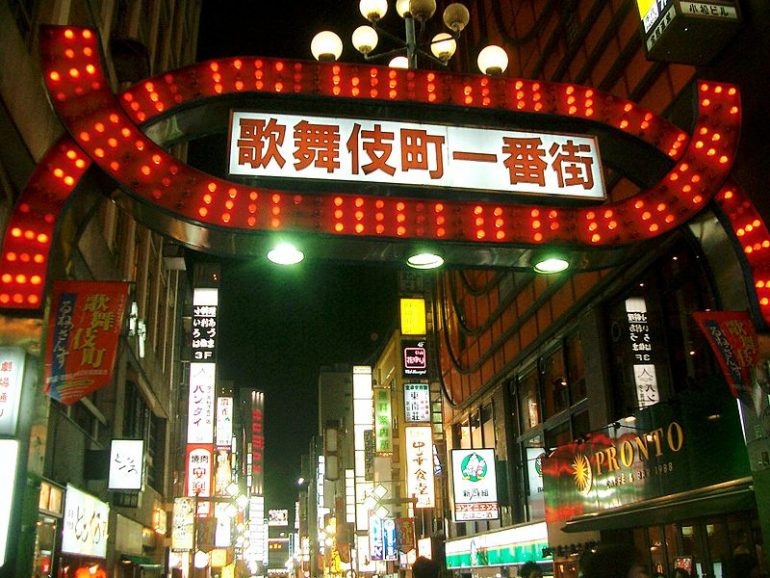The Transformative Violence of Yakuza 0

American culture’s relationship with violence in media has always been contentious. Violence is in everything, but there’s always a voice in the room trying to convince everyone of its corruptive force. This perspective tends to ignore how when we fictionalize violence, it stops being violence altogether, thematically changing itself into something that’s only as harmful as its message.
Yakuza 0 is a recent video game that’s all about violence. However, Yakuza 0 uses its medium’s expression of violence and frames its fictionalization in such a way to change how we think about the supposed inevitable.
The ability to fictionalize and re-frame violence is powerful. You probably saw this video: Richard Spencer, a white nationalist and advocate for ethnic cleansing, is standing before a television news crew. He’s talking casually, motioning towards the pin of a cartoon frog on his lapel when a masked man rushes into frame and lands a punch straight to his head. For many Americans right now, it was an improbable moment. One where their frustrations were physically excised on a mouthpiece for the source of their contempt.
What interested me so much about happened after wasn’t the discussion about violence’s role in discourse, but what people did with the video.
All across Twitter people were placing music tracks over the scene, ranging from Wu-Tang Clan to Aaron Carter, perfectly synchronizing the impact with the beat. When these started appearing, I felt like a kid again, trading links to my friends as if we were back on the playground, gleefully showing each other our most prized Pokémon cards.
The original video doesn’t really work without an investment in context—the audio is poorly mixed shouting and, like any act of real-world violence, the punch is too quick, too messy and both parties bolt within the second.
The remixes made the punch heard and brought a rise in anticipation with the pacing of the music, so when that climatic beat finally hits, it hits hard. Through the creation of a meme, they fictionalized a moment in time. They used music and timing to do what any great director does and controlled the audience’s reaction through an established tone.
They fictionalized the moment, but more importantly, they fictionalized the act of violence and enabled it to be about something more—something representative of the unrest of the political now.
That’s the thing with fictional violence—it’s never actually representative of real violence, but instead serves as a dramatic and thematic tool to convey a feeling or idea. This plays a large part into what makes the recent video game Yakuza 0 so compelling—it takes the traditional violence of crime fiction and repurposes that into this wider idea of constructive resistance.
Real violence is scary. It’s fast, bloody and cruel. Real world violence feels inescapable, and that inability to excise it from reality makes people actively afraid, demoralized, and often oppressed. The wrong people always seem to be getting killed, and there’s nothing we can do about it.
The general success of crime fiction often boils down to this ability to invert and re-contextualize violence. If we took the most successful crime stories on the shelf and examined them as real violence, we’d have to come to terms with characters like Lee Child’s Jack Reacher. His body count stretches past two hundred civilians, which would make it him the most successful serial killer in American history by a wide margin. In fiction, however, he’s a hero, because he takes the violence that we’d normally fear and controls it, turning it against the people ruining lives without repercussions.
In this way, crime fiction has stood out to become both popular and populist. When Dashiell Hammett has his gambler, Ned Beaumont, wear the hat of an amateur sleuth in The Glass Key, he may be friends with mob bosses, but the real threats prove to be politicians. Criminals are vulnerable, but the elite stay elite, so maybe this low-life outsider, wielding the same violence that’s used to shake down everyone else, can destabilize things.
The crime story strips back a chaotic reality to portray something that feels right. Raymond Chandler would describe The Glass Key in The Simple Art of Murder as how a realist writes a murder with “a world in which gangsters can rule nations and almost rule cities . . . here no man can walk down a dark street in safety because law and order are things we talk about but refrain from practicing.”
While a grim caricature, it captures an emotional perspective of the world and the ability of the protagonists of these novels, the Sam Spades and the Ned Beaumonts, to look into the lives of the doomed and use a type of violence to return justice. The reasoning is simplistic but compelling; we want to see a reality where the bad guys lose, and as the mystery writer Larry Beinhart would put it, “We don’t merely take pleasure in the fact that violence is taking place, it’s who it’s done to that makes us happy.”
What strikes me about Yakuza 0 is how the experience reflects a crime narrative where violence can be channeled not as a destructive and mitigating force, but as a reconstructive one.
Due to the mechanical nature of video games, their violence needs to be rewarding. There to needs to exist a positive feedback loop to keep players’ attention, and this can be traced in the sound design; the real thud with successful blows, and the visually complex and stylish flurry of moves that come from learning the right button combinations and timing.
Video game violence is generally exciting, but Yakuza 0 frames its violence in history. The game takes place in 1988 at the height and near-collapse of a Japanese economic boom.
As Kazama Kiryu, you wander underneath bright neon lights, past thumping discotheques and Sega arcades, surrounded by a sense of distracting opulence. Kiryu is a young, low-ranking yakuza enforcer framed for the murder of a man he shook down for a loan shark the same night. The yakuza are Japan’s real-life equivalent of the Mafia, but instead of operating in the shadows like criminals, they’re an accepted part of the landscape. Said landscape is quick to throw Kiryu under the bus for the crime, and he’s forced to go out to find the true murderer and prove his innocence.
The narrative at face value is cookie-cutter and pedestrian, falling in the line of good-guy-criminal stories like The Glass Key, with a noble mobster striking out as an amateur detective to take down someone much worse. The difference between the two narratives hinges on where they place their violence.
Kiryu initially aspires to maintain a vicious cycle. He was orphaned as a child and adopted by a leading member of a yakuza clan. That father figure, while off-screen, hangs over the narrative like a shadow. Kiryu was raised expecting to fill this role, so he turned himself into a vehicle for violence and prepared himself for little else. He’s only twenty, but the yakuza is the end goal. It’s the class space of his father and his best friend, and everything he’s expected to be.
By proving his innocence, Kiryu can reclaim his space within the yakuza clan. He can uphold and remain in the status quo.
This is 1988, however, and in three years’ time the real estate bubble will burst and plummet Japan into one of the worst economic declines in the nation’s history. Yakuza 0’s narrative stands on the precipice of what will be known as “the Lost Decade,” and the game knows it.
Crime fiction is traditionally meant to be contemporary. When Yuri Herrera wrote The Transmigration of Bodies, he constructed a fantastical but doomed city as a method of talking about the effects of the drug war in Mexico. In the novel, an unstoppable disease moves through the background, and its presence can be read in the city’s shuttered businesses, plague masks, and thinning streets. Bodies are piling up, and there’s a silent notion that nothing anyone can do will stop it. When the novel’s detective character, the Redeemer, arrives on the scene, the deaths have already happened, and as he navigates the city and its criminal hangouts, his goal becomes to mitigate the damage already taking place.
In The Transmigration of Bodies, much like The Glass Key, the fear of death and violence is already present and in control. The best that we can do is step quietly and land our punches where we can.
In Yakuza 0, however, nothing about violence is quiet. Kiryu effortlessly picks up parked motorcycles and swings them like baseball bats through squads of hapless thugs. He bashes faces against walls and breaks bicycles across bodies. His limbs glow with his success. Around one corner is a group of rival yakuza ready to remove his head from his shoulders, and around the next is a group of punks mugging an innocent. These fights pepper the environment, and even when you ignore them, they come towards you.
This environment would be horrific and dystopian anywhere else—something more akin to a Mad Max movie.
When the journalist and writer of the novel Tokyo Vice, Jake Adelstein, interviewed three retired members of the yakuza and had them play the third game in the Yakuza series, they were quick to note the lack of realism in the game’s violence. One explained: “No yakuza is going to run around getting into fistfights like that. . . . He’ll wind up in jail or in the hospital or dead, maybe even whacked by his own people for being a troublemaker. . . . Guys like that start gang wars and nobody wants that now.” Violence is inherently unrealistic and different for Kiryu. He’s not just some guy.
Kiryu’s brand of bombastic violence explicitly defies an established understanding of reality, and in keeping with that theme, the character delivers a type of violence that’s constructive rather than destructive. No matter how badly you kick them in, how many walls you slam their faces into, or boxes you break on them, the enemies pull themselves off the ground and apologize every time. They swear off their ways, they promise to never do it again.
No one actually dies in Yakuza 0, and while this might remove any realism or weight from the violence, it allows us to look at the historical context of the narrative and ask, “do things really have to happen like this?”
The deeper Kiryu gets into the conspiracy surrounding the murder, the more evident it becomes how much of the pain and turmoil is about real estate, the mishandling of the economy, and the downfall heading their way. These moments of plot are quiet and subdued. They unfold over cigarettes and drinks in the backrooms of bars. These things are calculated, business as usual, and for that reason an economic collapse is evident.
Kiryu isn’t business savvy, he’s not calculating. What he’s really good at is hitting people. The bombast of his violence provides a vehicle of promise that maybe, just maybe, the cycle of predicted history can be broken—the future can be changed. The all-consuming despair and cynical expression of environment that our crime story protagonist navigates and punches back against is ultimately not a thing present, but a thing to come, and Kiryu’s violence becomes not a tool of defense and justice, but a preventive tool against a harmful future.
The desire to change history is layered through the game. One particular (optional) side-story involves the game’s second protagonist, Goro Majima, rescuing a young woman from a cult on behalf of her mother. The cult is primarily played for laughs as Majima fumbles his way through their recruitment process, but historical context is again inescapable. This is 1988, and the cult visually and operationally mirrors the very real Japanese doomsday cult Aum Shinrikyo. Haruki Murakami detailed the cult in his non-fiction book Underground, and we can easily draw parallels to Aum’s religious clothing, hierarchy, and method of recruitment by preying on individuals lost in society. The young woman in the game recently lost her father and has offered up her family ties, money, and dignity to the cult for nothing in return. Majima goes in and saves her, beats up the cult leader, and reveals him to be a money-obsessed fraud.
This in 1988, and in 1995, Aum Shinrikyo would carry out a sarin gas attack on the Tokyo subway system that would harm over four thousand people and kill twelve. Another terrible future now averted.
Even in fiction, there’s a general acceptance that history must be consistent with our own—that things are the way things are. Jim Shepherd plays this against the reader in his short story “Love and Hydrogen,” where the reader must listen in on the lives of the characters as they work as engineers on the Hindenburg. The text never alludes to the assumed doom, but history hangs over the story like a piano on a wire, and we’re helpless to wait for history to catch up.
Yakuza 0 uses its violence as all the best violence is used—as resistance. When forced to stare at the oncoming wave of tragic history, violence becomes a method to ask, “Do we really have to accept this?” The violence enacted across the game is used less for vengeance than it is for correcting mistakes—for seeing something wrong and stepping out in front of it.
Our political climate provides voices from all sides whispering that “this is just the way things are,” to be docile and compliant in a situation that we can easily read as bad. Yakuza 0’s violence is a thematic antidote to this sentiment. It reminds us of our own agency in the events of our lives, even in the face of an inevitable and cyclical history.


